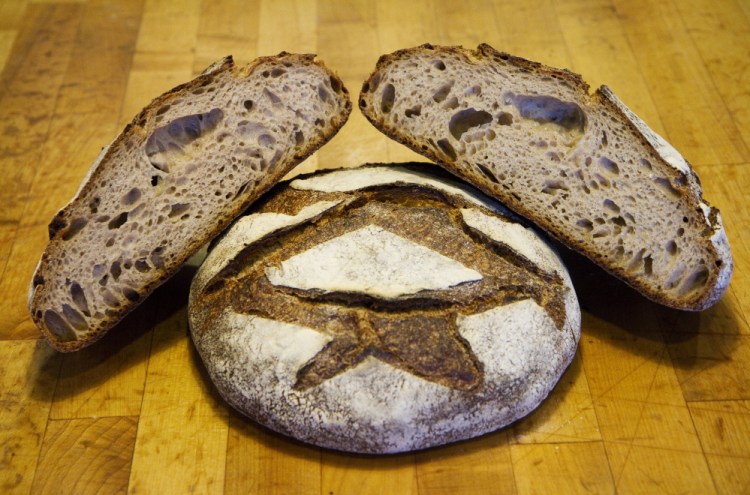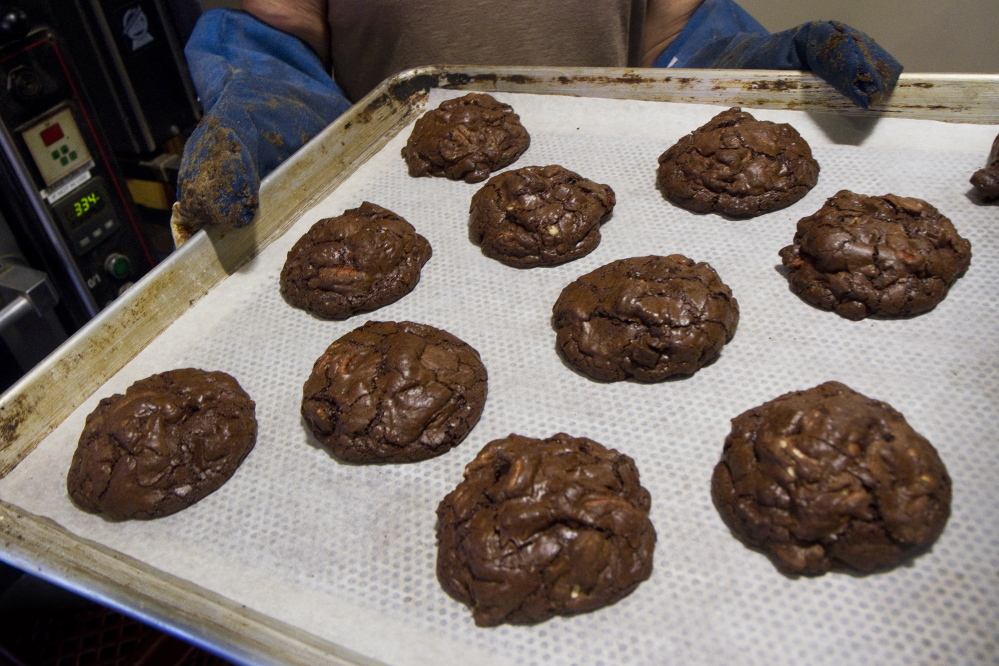The new chunky chocolate rye cookie at Standard Baking Co. is thick like a brownie, and when you bite into it, little pools of bittersweet chocolate ooze out onto your tongue.
Some of the staff balked at adding “rye” to the name because they were afraid it would turn customers off. Rye, after all, conjures images of a dense deli bread dotted with caraway seeds. But that hasn’t been the case. The rich cookie tastes like chocolate and has been selling out regularly since it was introduced about a month ago.
So, where is the rye?
Oh, it’s in there. While you eat the triple chocolate cookie, the organic rye flour (made from Benedicta rye grown in Aroostook County) soaks up some of the guilt.
Alison Pray, co-owner of the bakery, believes that if a local, organic flour with more fiber in it can be substituted for a white flour from the Midwest in some of her products, why not? Switching to local grains means supporting local farmers and – in the case of the cookie – “creating more nutritional value in something that’s a treat and an indulgence.”
“You will never know the difference,” she said, “but you are eating a better quality food.”
As grain farming begins to gain a real foothold in Maine, and with the start-up of a mill in Skowhegan that can turn grains into flour, local grains are becoming available in large enough quantities that professional bakers can experiment with them seriously and use them more extensively.
Standard Baking Co. is one of several Maine bakeries working to incorporate more Maine-grown grains into their breads and pastries.
Bakers are changing recipes to fit the behavioral characteristics of the new flours milled from these local grains, and daydreaming about all the new products they’ll be able to create.
At Standard Baking, the staff makes breads with local wheat, including a round miche loaf made with 100 percent Maine flour. Standard also sells a scone made with local buckwheat. On the drawing board is a Danish that will contain some Maine wheat, enough to add back some of the nutrition taken out of conventional white flour. Ultimately, Pray would like to switch to Maine-milled flour in 80 percent of her pastries.
Forage Market in Lewiston and Scratch Bakery in South Portland are using local grains in larger quantities, too, according to Amber Lambke, president of Maine Grains at the Somerset Grist Mill in Skowhegan and executive director of the Maine Grain Alliance. Smaller bakeries such as The Bankery in Skowhegan, Good Bread in Brownfield and Hootenanny Bakery in Damariscotta are also switching over to some extent.
“We work out of a wood-fired oven, and we make all of our products from scratch with natural starters, so it’s a really important thing to us that we can incorporate the local, organic grains,” said Allen Smith, owner of Forage Market, who believes local grains have more vitamins. “(Maine grains) are not 100 percent organic, but it really fits with what we’re doing here.
“We blend them into almost all of our breads at about a 10 percent rate,” Smith said. “We use them for the whole grain portion of breads that have mixed white and whole grain. And then we have a few loaves that we make that are almost entirely whole grain.”
LOCAL GRAINS ‘A BEAUTIFUL THING’
In 2009, Standard Baking Co. used 7,000 to 8,000 pounds of local grains, mostly a whole grain mix of spelt, corn, wheat, oats and rye. This year, the bakery will purchase about 40,000 pounds of local wheat, oats and rye, and some cornmeal and whole spelt.
As so-called ancient grains with great baking properties become more available – emmer, faro and einkorn, for example – Pray plans to use them to create porridge breads and other new products. (A porridge bread is a dense bread made with soaked grains.)
Unlike wine makers, who regularly get to see and taste the grapes that will go into their wines, modern bakers have long been separated from their raw materials. The availability of local grains means they can get samples of flour to bake with and taste early. That means that even if a flour is harder to work with, it will be easier to make the adjustments needed to get good results.
“It’s a beautiful thing,” Pray said. “It brings it so much more to life.”
Smith said he recently got a sample of red fife, an heirloom wheat that is getting renewed attention because of its flavor. He said he’s looking forward to baking bread with it because the flavor of the sample “was phenomenally good.”
For the past four years, Pray has been working with the Northern Grain Growers Association and the Northern New England Local Bread Wheat Project at the University of Maine, a collaboration of researchers, farmers, millers and bakers in Vermont and Maine. They occasionally send her four or five new heritage wheat varieties to bake with so she can evaluate their properties and flavor.
Sometimes the wheat berries used to make the flour, say, were grown on the same farm but on different plots of land, which helped narrow down the best growing conditions.
“Through those tests we have found varieties that are far superior, really stand out noticeably above so many others, and at the same time have grown really easily on a Maine farm or a Vermont farm,” Pray said.
For most people the difference in flavor using a local whole grain flour might be subtle, Pray said, “but if you’re tasting them side by side and evaluating them, there are very obvious differences in taste.”
“We use adjectives for the taste of whole grain flours almost in the way that wine tasters taste wine – fruity, nutty, grassy, earthy, could be bitter,” she said. “So there are differences in taste. There are differences in texture. The primary difference is in the qualities of the protein. Protein is what gives bread strength, gives it the ability to rise, gives it its shape.”
Last year was the first full year that Standard Baking Co. has been able to use local crop wheat – a variety called AC Brio.
Lambke said the AC Brio was grown in Mapleton, in Aroostook County, by Tate McPherson of Maine Seed Co., a third-generation potato grower who is one of the more experienced grain growers in the state. McPherson, she said, works with his cousins and other farmers to piece together large plots so they can provide the Skowhegan mill with sizable amounts of grain.
Until the Skowhegan mill came along, the farmers had been accustomed to selling their grains to oat processing and malting facilities in Canada, and to mills in Quebec.
KNOW YOUR MILLER
Being able to buy local flour in quantities that will last through the harvest season is important to bakeries because every time the characteristics of a flour change, they need to change their recipes and techniques. Bakeries already do this to a lesser extent from season to season, as conventional flour from the previous year’s crop is switched to a flour from the latest growing season that has different characteristics. There may have to be changes in how the flour is mixed, how much water is added to it, or how the dough is folded and stretched. The loaf might have to go into the oven an hour earlier. “We’ll adjust every step of the process based on the behavior of the flour,” Pray said.
Ignoring the differences between old- and new-season flours means inconsistent results – a loaf of flat bread that isn’t supposed to be flat, for example.
It’s the same with local flours, perhaps even more so. Last year, Standard Baking used a small percentage of AC Brio in a variety of breads, and 100 percent in a miche loaf.
About two weeks ago, the bakery made the transition to an entirely different variety of bread wheat called Magog – also grown in Mapleton. (Pray plans to start labeling her breads with the wheat varieties used in them.)
Lambke sent Pray some early samples of the Magog flour so she could do some baking tests and get a head start on how the bakery might have to change its formulas.
“This is the beauty of working closely with your miller, knowing your miller,” Pray said. “This is how bakers work in France – they know their miller and their farmer.”
The rye in the chunky chocolate rye cookies (and in Standard Baking’s two rye breads) was grown by Jake Dyer, an organic grain grower in Benedicta.
The idea for the treat came from a rye research trip Pray recently took to Denmark and Germany. She tasted a lot of pastries made with rye flour, and fell in love with one in Germany that looked like and had the texture of rye bread but also contained chocolate and a little orange zest.
Pray said she’s been “really pleased” with the customer response to the cookies.
“People who thought it was questionable fell in love with them,” she said. “And I’m just so thrilled that we can use yet another local ingredient in one of our menu items and feel good about supporting local farms.”
Copy the Story Link
Send questions/comments to the editors.





Success. Please wait for the page to reload. If the page does not reload within 5 seconds, please refresh the page.
Enter your email and password to access comments.
Hi, to comment on stories you must . This profile is in addition to your subscription and website login.
Already have a commenting profile? .
Invalid username/password.
Please check your email to confirm and complete your registration.
Only subscribers are eligible to post comments. Please subscribe or login first for digital access. Here’s why.
Use the form below to reset your password. When you've submitted your account email, we will send an email with a reset code.